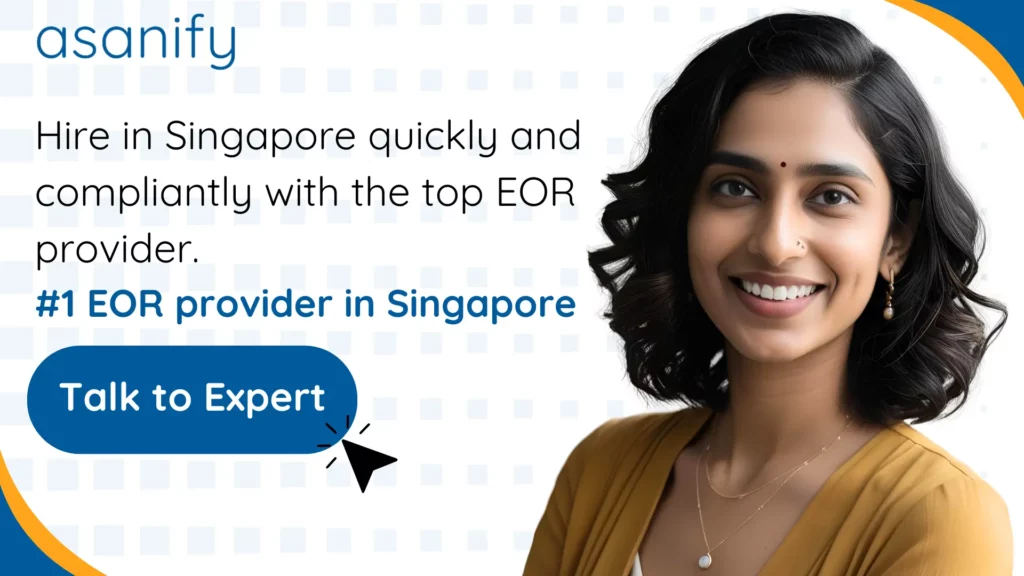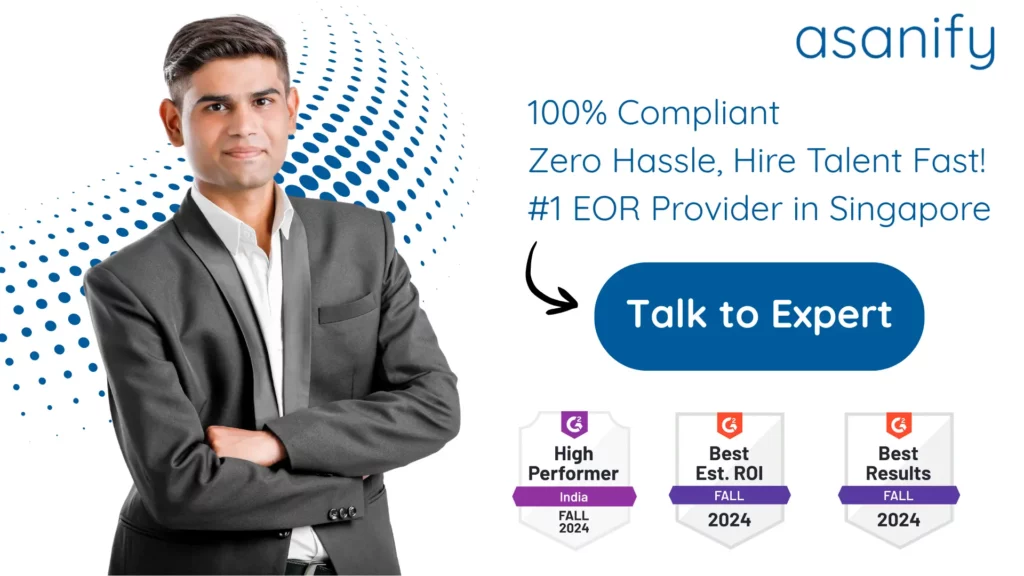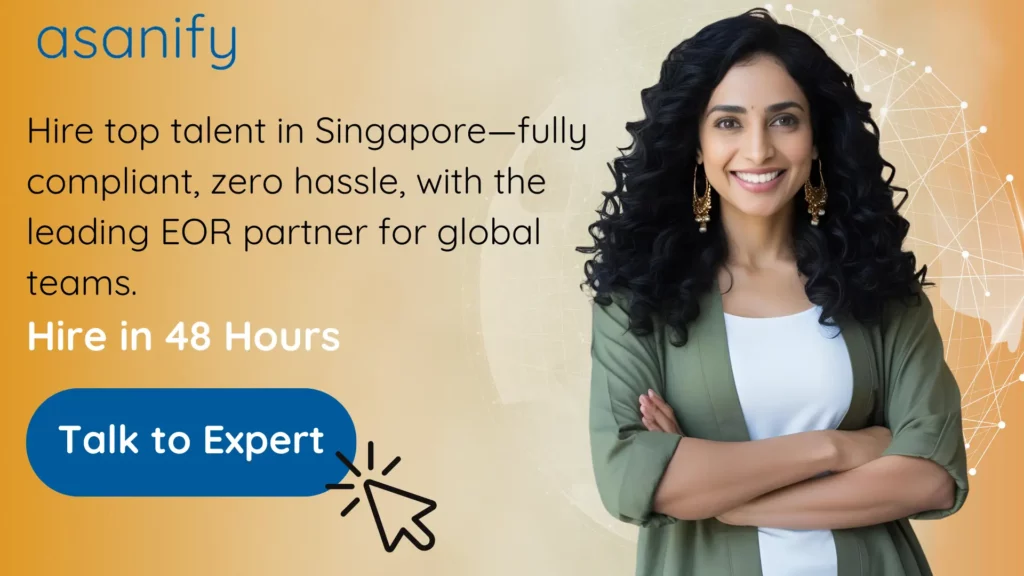Hiring your first remote employee in Singapore is a strategic milestone for any global company. However, after the offer letter is accepted, onboarding becomes the most critical phase to ensure compliance, employee engagement, and long-term success. Without a structured and locally compliant process, even top talent can feel disconnected or uncertain. That’s where an Employer of Record (EOR) in Singapore proves invaluable—managing Ministry of Manpower (MOM) compliance, CPF contributions, tax filings, and employment contracts. This Onboarding Checklist helps you navigate every essential step of the process, from legal documentation to cultural orientation, so your new hires feel supported, informed, and ready to contribute from day one—all while keeping your business 100% compliant.
Table of Contents
- Employee Onboarding Process in Singapore
- Before the Job Offer Letter
- After the Job Offer Letter
- On Joining Day
- Post-Onboarding Support
- Seamless Onboarding in Singapore with Asanify
- conclusion
- FAQs
Employee Onboarding Process in Singapore
An EOR in Singapore acts as the legal employer for your remote hires. While your company retains control over daily tasks and goals, the EOR assumes responsibility for employment documentation, payroll setup, statutory contributions, and MOM compliance.
Benefits of EOR-based onboarding in Singapore include:
- Compliant employment under Singapore’s Employment Act
- Proper CPF (Central Provident Fund) and tax deductions
- Efficient contract creation and payroll setup
- A smooth and consistent employee onboarding experience
Before the Job Offer Letter
At this stage, the client company and EOR partner begin laying the foundation for successful onboarding, including candidate vetting, compliance review, and role clarity.
Client Company Responsibilities:
- Shortlist and interview candidates
- Define role expectations, compensation, and remote work logistics
- Align salary with local benchmarks and CPF eligibility
EOR Responsibilities:
- Right to Work Validation: Ensure eligibility to work in Singapore (citizens, PRs, or visa holders)
- Employment Act Compliance: Advise on leave entitlements, notice periods, and contractual norms
- CPF Classification: Assess whether the employee qualifies as a CPF-contributing employee

After the Job Offer Letter
Once the candidate accepts the offer, the EOR assumes control of legal, payroll, and registration processes.
EOR Responsibilities:
- Draft a MOM-compliant employment contract
- Submit work pass applications (if applicable)
- Collect documents: NRIC or FIN, bank account, tax ID (IRAS)
- Register for CPF, Skills Development Levy (SDL), and contribute to Self-Help Group (SHG) funds
Client Company Responsibilities:
- Share onboarding materials and company culture deck
- Provide tools and system access (email, project management, Slack, etc.)
- Assign a buddy or mentor for smooth integration
Suggested Read: Pay Contractors in Singapore: A Complete Guide to the Hiring Process
On Joining Day
The first day sets the tone for productivity and engagement. The EOR handles formal compliance tasks while the client company welcomes the employee.
EOR Responsibilities:
- Finalize contract and ensure CPF registration is active
- Add employee to payroll system
- Provide employee access to payslips, leave policies, and CPF statements
Client Company Responsibilities:
- Conduct a welcome session with leadership or team
- Share company vision, remote work expectations, and performance goals
- Ensure the employee has the right hardware, tools, and resources

Post-Onboarding Support
Post-onboarding is just as important to retain employees and foster long-term satisfaction. EORs and client companies collaborate to provide ongoing support.
EOR Responsibilities:
- Manage monthly payroll, CPF contributions, and tax deductions
- Track leave and benefits according to Singapore’s labor laws
- Provide updates on regulatory changes
Client Company Responsibilities:
- Set 30-60-90 day plans for performance tracking
- Conduct regular check-ins and feedback sessions
- Offer career growth, training, and employee engagement programs
Seamless Onboarding in Singapore with Asanify
Asanify takes care of all the legal, HR, and payroll tasks required for onboarding in Singapore. With strong knowledge of CPF rules, MOM regulations, and bilingual support, we ensure a fast and frictionless employee experience.
Localized Onboarding Experience
Asanify ensures culturally relevant and contractually accurate onboarding, tailored to Singaporean legal frameworks and remote work norms.
Payroll & Equipment Support
We handle device provisioning and retrieval across Singapore. Your remote team gets paid on time with complete CPF and tax compliance handled automatically.
Compliance & HR Automation
Asanify’s platform automates monthly payroll, CPF filings, tax submissions, and supports digital HR operations—letting you stay compliant with minimal effort.
Full Lifecycle Support
From the first interview to conversion into a full-time direct hire, Asanify stays with you—managing onboarding, offboarding, and everything in between.

Conclusion
Onboarding remote employees in Singapore requires more than just paperwork—it demands full compliance with CPF, MOM regulations, and cultural integration. A structured process ensures your new hires feel engaged, supported, and productive from day one. Partnering with an Employer of Record (EOR) like Asanify simplifies this journey. Asanify handles employment contracts, payroll, statutory contributions, and equipment logistics while you focus on growth. With localized expertise and end-to-end support, Asanify ensures every new hire in Singapore is onboarded smoothly, legally, and efficiently. Whether you’re scaling or just starting, an EOR helps you build a compliant and committed remote team.
Suggested Read: EOR Singapore: A Detailed Guide 2025
FAQs
MOM-compliant contract, CPF registration, work pass if needed, and salary setup.
Yes, English is the official business language. Contracts should be clear and in English.
CPF, SDL, SHG contributions, and IRAS income tax withholding as applicable.
Yes. Foreigners need valid work passes. Locals are registered with CPF and tax.
Yes, providers like Asanify manage hardware logistics.
Typically 5–7 business days depending on visa or documentation readiness.
Yes. Asanify supports EOR onboarding in multiple Asian markets from one dashboard.
You gain speed, legal peace of mind, and local HR support without setting up an entity.
Absolutely. Asanify facilitates smooth contract transitions when you establish a legal entity.
Asanify ensures that contracts, working hours, leave, and CPF are compliant from day one.
Not to be considered as tax, legal, financial or HR advice. Regulations change over time so please consult a lawyer, accountant or Labour Law expert for specific guidance.

